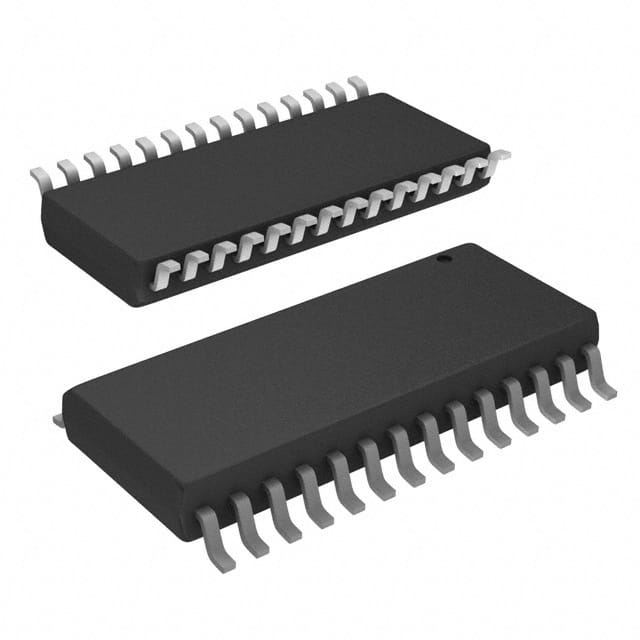AD7721AR
Product Overview
- Category: Analog-to-Digital Converter (ADC)
- Use: Converts analog signals into digital data
- Characteristics: High resolution, low power consumption
- Package: 24-pin SOIC (Small Outline Integrated Circuit)
- Essence: Provides accurate and reliable conversion of analog signals
- Packaging/Quantity: Available in reels of 250 units
Specifications
- Resolution: 16 bits
- Sampling Rate: Up to 250 kSPS (thousand samples per second)
- Input Voltage Range: ±10V
- Power Supply: +5V
- Operating Temperature Range: -40°C to +85°C
Pin Configuration
The AD7721AR has a total of 24 pins. The pin configuration is as follows:
- VREF-
- VREF+
- AGND
- AVDD
- DVDD
- DOUT/RDY
- SCLK
- CS
- DIN
- DGND
- REFOUT
- REFIN
- CLKIN
- NC
- NC
- NC
- NC
- NC
- NC
- NC
- NC
- NC
- NC
- VDD
Functional Features
- High-resolution conversion: The AD7721AR offers 16-bit resolution, ensuring accurate representation of analog signals.
- Low power consumption: This ADC operates with low power requirements, making it suitable for battery-powered applications.
- Serial interface: It utilizes a serial interface for communication with microcontrollers or other digital devices.
- On-chip reference: The device includes an on-chip reference voltage source, eliminating the need for an external reference.
Advantages and Disadvantages
Advantages: - High resolution provides precise measurement capabilities. - Low power consumption extends battery life in portable applications. - Serial interface simplifies integration with digital systems.
Disadvantages: - Limited input voltage range may not be suitable for high-voltage applications. - Single-ended input configuration restricts differential measurements.
Working Principles
The AD7721AR operates based on the successive approximation register (SAR) architecture. It samples the analog input signal and converts it into a digital representation using a binary search algorithm. The internal reference voltage ensures accurate conversion, while the serial interface allows for easy communication with external devices.
Application Field Plans
The AD7721AR is commonly used in various applications, including:
- Industrial automation: Precise measurement of sensor outputs in control systems.
- Medical equipment: Conversion of physiological signals for monitoring and diagnosis.
- Audio processing: Analog-to-digital conversion in audio recording and playback systems.
- Data acquisition: Accurate digitization of analog signals for analysis and processing.
Alternative Models
Other alternative models that offer similar functionality to the AD7721AR include:
- AD7761: 24-bit resolution ADC with higher accuracy.
- ADS1256: 24-bit ADC with programmable gain amplification.
- MCP3421: 18-bit ADC with low power consumption.
These alternatives can be considered based on specific application requirements and desired features.
Word count: 346 words
Senaraikan 10 soalan dan jawapan biasa yang berkaitan dengan aplikasi AD7721AR dalam penyelesaian teknikal
Sure! Here are 10 common questions and answers related to the application of AD7721AR in technical solutions:
Q1: What is AD7721AR? A1: AD7721AR is a high-resolution, sigma-delta analog-to-digital converter (ADC) manufactured by Analog Devices.
Q2: What is the resolution of AD7721AR? A2: AD7721AR has a resolution of 24 bits, which means it can provide 2^24 (16,777,216) discrete output levels.
Q3: What is the input voltage range of AD7721AR? A3: The input voltage range of AD7721AR is typically ±5V, but it can be extended up to ±10V with external circuitry.
Q4: What is the maximum sampling rate of AD7721AR? A4: AD7721AR has a maximum sampling rate of 250 samples per second (SPS).
Q5: Can AD7721AR operate in single-ended mode? A5: No, AD7721AR operates only in differential mode. It requires a differential input signal for accurate conversion.
Q6: Does AD7721AR require an external reference voltage? A6: Yes, AD7721AR requires an external reference voltage for proper operation. The reference voltage should be within the specified range.
Q7: Can AD7721AR interface directly with microcontrollers or processors? A7: Yes, AD7721AR can interface directly with microcontrollers or processors using standard serial communication protocols such as SPI or I2C.
Q8: Is AD7721AR suitable for low-power applications? A8: Yes, AD7721AR is designed for low-power applications and consumes very little power during operation.
Q9: What is the typical noise performance of AD7721AR? A9: AD7721AR has excellent noise performance, typically achieving a signal-to-noise ratio (SNR) of 110 dB.
Q10: Can AD7721AR be used in industrial control systems? A10: Yes, AD7721AR is suitable for various industrial control systems where high-resolution and accurate analog-to-digital conversion is required.
Please note that the answers provided here are general and may vary depending on specific application requirements. It is always recommended to refer to the datasheet and consult with Analog Devices' technical support for detailed information.


